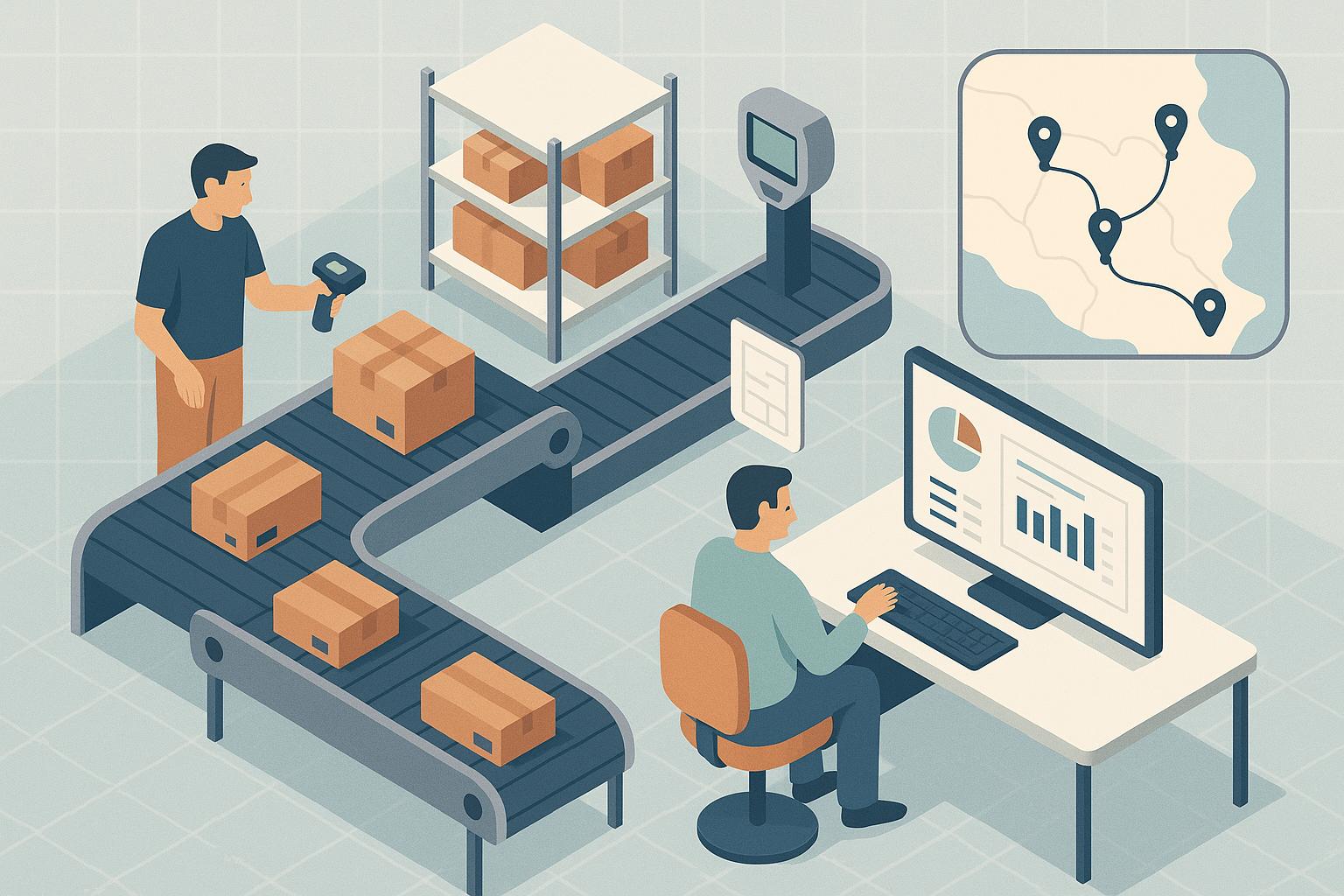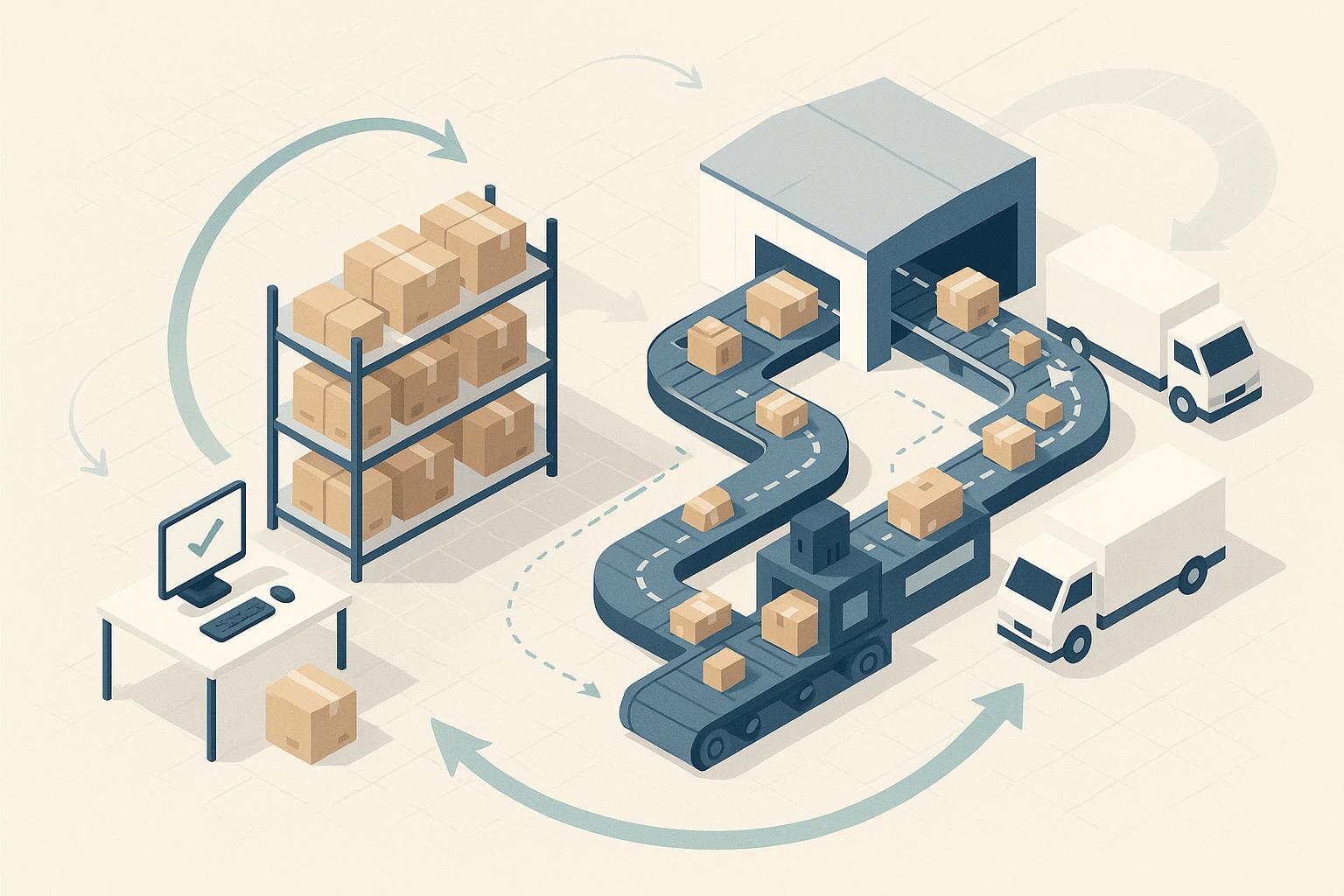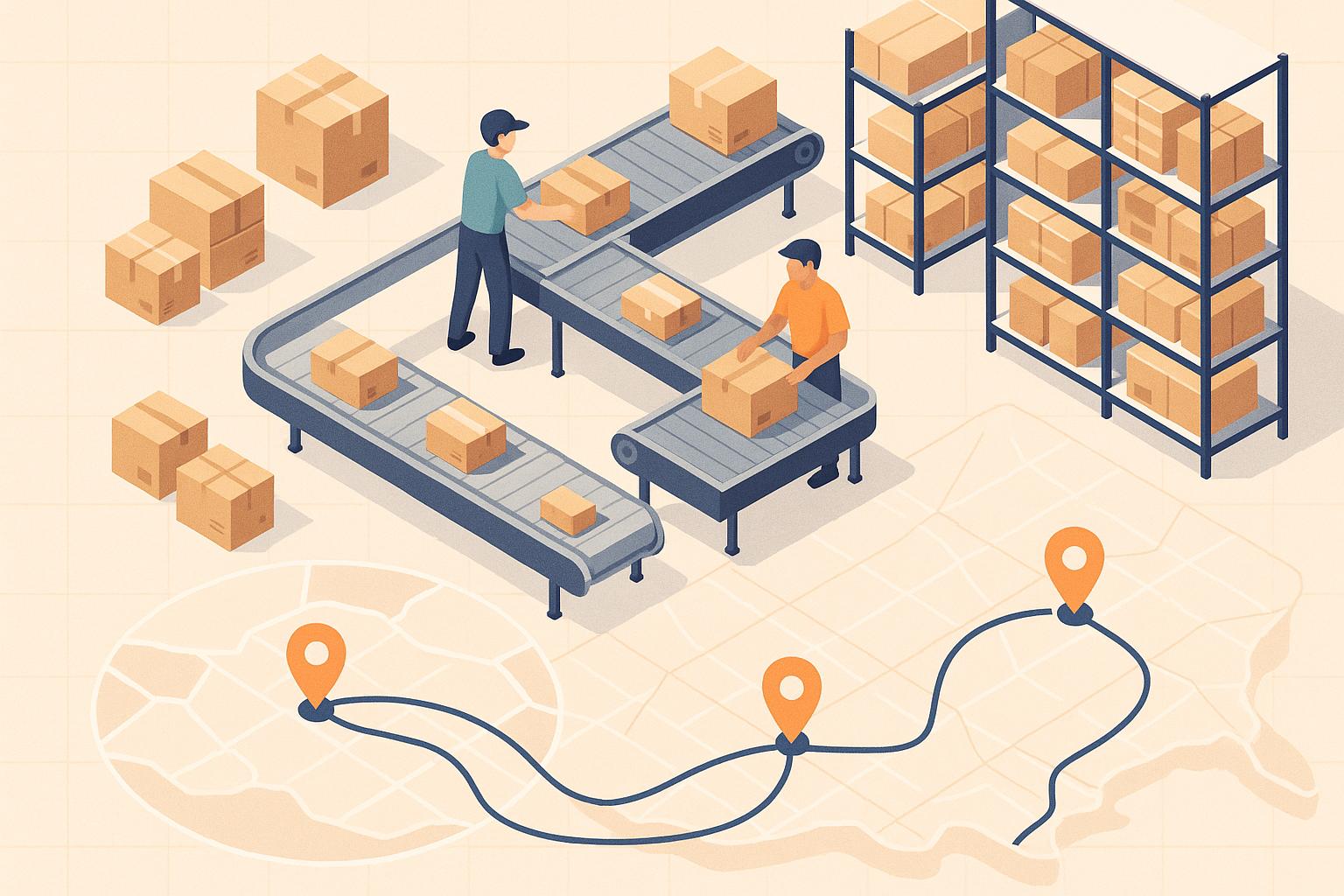- Order Fulfillment: DTC brands require 3PLs capable of handling small, frequent orders with speed and precision.
- Scalability: The ability to manage sudden spikes in demand, like viral campaigns or seasonal sales, is crucial.
- Custom Packaging: Many DTC brands rely on branded packaging and inserts to maintain a strong brand identity.
- Technology Integration: Seamless connection with platforms like Shopify and real-time inventory tracking are essential.
- Distributed Inventory: Multiple fulfillment centers help reduce shipping costs and meet fast delivery expectations.
- Returns Management: Efficient reverse logistics ensures a smooth customer experience.
Key takeaway: The right 3PL acts as an extension of your team, aligning with your brand's values and operational priorities to support growth and improve the customer experience.
DTC Brand Logistics Requirements and Challenges
Common DTC Logistics Problems
Running a direct-to-consumer (DTC) brand comes with its own set of logistical hurdles that traditional fulfillment operations often struggle to manage.
One major issue is small order quantities. Unlike B2B operations that might ship hundreds of units at once to a retailer, DTC brands typically deal with individual orders of one or two items. This requires a 3PL partner with systems designed to handle frequent, small-scale picking and packing while maintaining speed and accuracy.
Another challenge is unpredictable order volumes. A single viral TikTok or a successful influencer campaign can send daily orders skyrocketing from 50 to 5,000 in a matter of hours. Your logistics partner must be able to scale operations quickly during these spikes while still delivering consistent service during quieter periods.
Custom packaging requirements also set DTC brands apart. Unlike wholesale businesses that use plain boxes, DTC brands often need branded packaging, personalized inserts, gift wrapping, or specific unboxing experiences that reflect their identity. Many 3PLs aren't equipped to handle these specialized needs.
For niche brands, inventory complexity adds another layer of difficulty. A skincare brand, for instance, might carry 30 SKUs with varying storage needs, shelf lives, and seasonal demand. Managing this requires sophisticated inventory systems and staff trained in product-specific handling.
Lastly, returns processing can become a logistical nightmare. With return rates ranging from 15-30%, each item must be inspected, restocked, and sometimes refurbished before it can be resold. This reverse logistics process demands dedicated workflows, which many traditional 3PLs lack.
These logistical issues don’t just complicate operations - they can also directly impact customer satisfaction.
How Logistics Affects Customer Satisfaction
Every step of the logistics process shapes how customers perceive your brand. A single misstep can erode trust and loyalty.
Delivery speed is a critical factor. Today’s customers expect their orders to arrive in 1-2 days. Delays, even if minor, can overshadow the quality of your product and leave customers frustrated.
Packaging presentation is another make-or-break moment. The box your customer opens is often their first physical interaction with your brand. Damaged or generic packaging - or worse, missing promotional materials - can make your brand seem careless. On the flip side, thoughtful packaging can create memorable unboxing experiences that encourage word-of-mouth referrals.
Order accuracy is essential, especially when customers are relying on specific products for immediate use. Shipping the wrong item or leaving something out forces customers to deal with support, wait for replacements, and question your reliability. For niche brands, where word-of-mouth is everything, this can be especially damaging.
Communication and tracking play a huge role in managing expectations. Accurate tracking updates and proactive communication reduce customer anxiety and cut down on support inquiries.
Finally, the returns experience can turn a dissatisfied customer into a loyal one - or drive them away for good. A smooth, hassle-free return process shows that you value your customers, even when something goes wrong.
Aligning 3PL Services with Brand Values
Choosing the right 3PL partner isn’t just about logistics - it’s about finding a partner that aligns with your brand’s identity and priorities. The wrong choice can send mixed signals to your customers.
For brands focused on environmental responsibility, it’s important to work with 3PLs that offer eco-friendly packaging, carbon-neutral shipping, and waste reduction strategies. A disconnect here can weaken your sustainability message and alienate eco-conscious customers.
If your brand is positioned as premium, your 3PL must match that level of service. This includes white-glove handling, high-end packaging, and meticulous attention to detail. Treating premium products like ordinary items can tarnish your brand’s reputation.
Brands that emphasize local community support may prefer 3PLs with fulfillment centers in specific regions or those that hire locally. This reinforces messaging around supporting local economies and reducing shipping distances.
For tech-forward brands, technology innovation is a must. Advanced warehouse automation, real-time inventory tracking, and seamless integrations are essential. Outdated systems can make even the most cutting-edge brand look outdated.
Lastly, brands that value transparency and communication need 3PL partners who provide detailed reporting, maintain open communication, and address problems head-on. A lack of transparency can undermine trust, both with your 3PL and your customers.
The bottom line? Your 3PL should reflect the same standards and values your brand represents. This ensures that every customer interaction - whether it’s unboxing a package or processing a return - reinforces your brand identity.
How to Choose the Right 3PL: Why Customer Service Matters in Fulfillment, Dave Gulas EZDC3PL
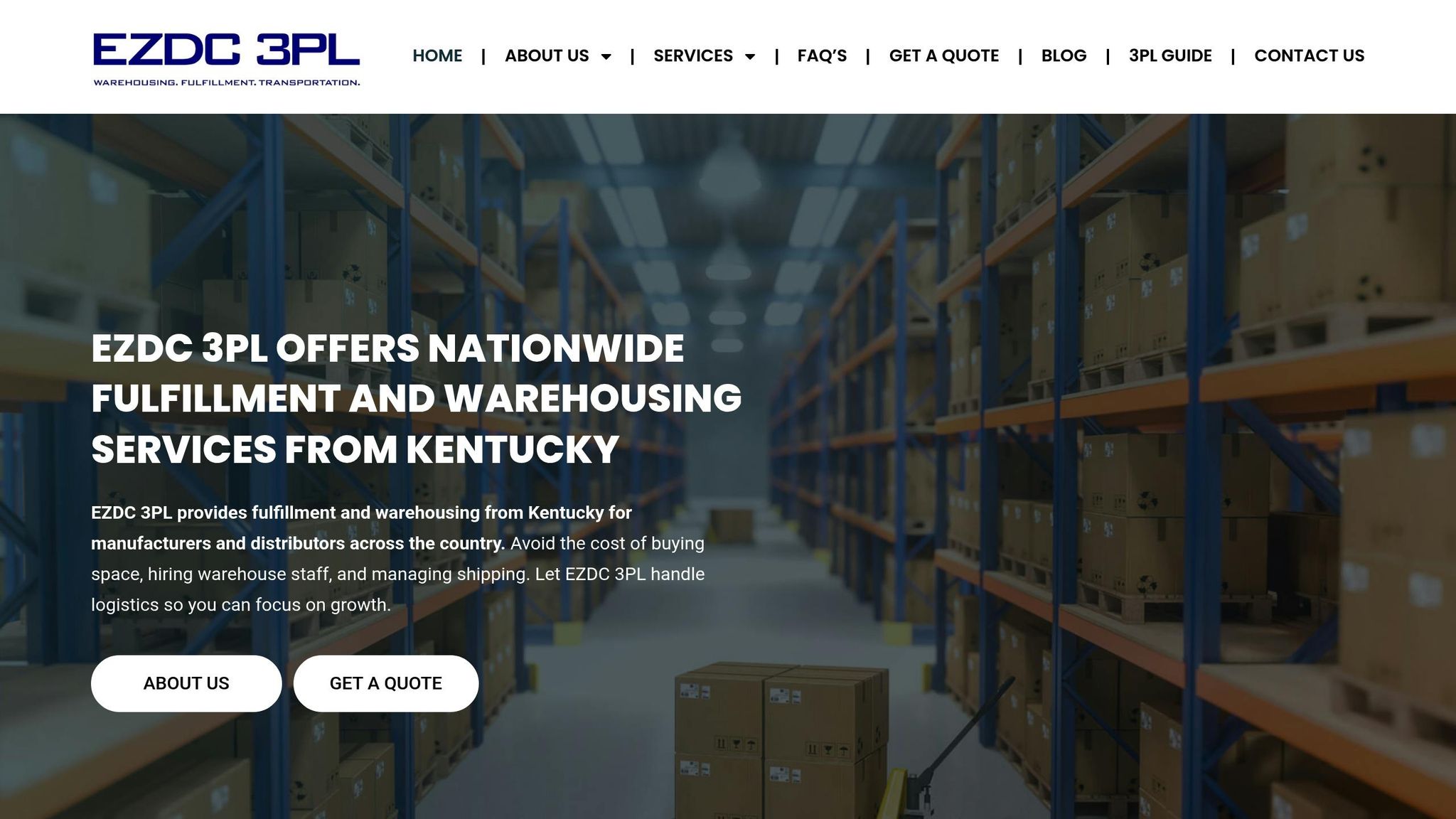
How to Evaluate 3PL Providers for DTC Brands
Choosing the right 3PL partner isn’t just about comparing prices - it’s about finding a provider that aligns with your brand’s unique needs. For DTC brands, this means digging into the details that directly affect customer experience and operational efficiency.
DTC Experience and Specialized Skills
Your logistics challenges demand a provider that understands the specific needs of DTC businesses.
- Single-item order expertise: Many DTC brands deal with smaller, single-item orders. Ask potential 3PLs about their strategies for handling these efficiently - whether through zone picking, batch processing, or automation tools designed for single-item shipments.
- Custom packaging capabilities: Packaging is a chance to make a lasting impression. Don’t settle for vague promises; ask for examples of branded packaging they’ve handled, like including promotional inserts or managing delicate items.
- Product bundling and kitting: If your brand offers bundles or kits, assess their experience with assembling these. Look into their quality control measures and how they manage inventory for bundled components.
- Specialized handling: Different industries have unique requirements. Beauty brands may need temperature-controlled storage, apparel companies might require hanging storage, and food brands often need FDA-compliant facilities and lot tracking. Confirm the provider’s certifications and experience align with your product’s needs.
Technology Compatibility and Integration
Smooth operations rely on seamless data flow. Make sure the 3PL’s technology can integrate directly with your eCommerce platform, whether it’s Shopify, WooCommerce, BigCommerce, or Magento. Beyond that, look for features like:
- Sophisticated inventory management with tools for lot tracking and expiration dates
- Real-time reporting dashboards for better visibility
- Flexible APIs for integrating additional tools as your business grows
Also, consider their capacity for supporting your long-term growth. Can their systems and infrastructure scale alongside your business?
Growth Capacity and Geographic Coverage
Efficient scaling is critical for DTC brands, and your 3PL should be ready to grow with you.
- Scalability during peak periods: Ensure the provider can handle high-demand times like Black Friday or viral campaigns. Ask about their strategies for managing peaks, such as temporary staffing and prioritizing orders.
- Multi-location fulfillment: A network of strategically located warehouses allows for faster shipping (1-2 days) and better inventory management. Check if they have systems in place to balance stock across locations.
- International shipping expertise: If global expansion is on your horizon, look for 3PLs experienced in customs documentation, duty calculations, and processing international returns. They should also be familiar with regulations in your target markets.
Lastly, verify their warehouse management systems can adapt as your business grows. Ask about their largest clients and how they handle capacity planning for scaling brands.
Evaluating 3PL providers takes time and thorough research. Request detailed proposals, speak with references, and, if possible, visit their fulfillment centers. A reliable 3PL partner will be upfront about their strengths and limitations, helping you make an informed decision that supports your brand’s growth.
Adapting 3PL Services for Your Brand Requirements
After identifying potential 3PL providers, the next step is tailoring their services to align with your brand's specific operational and customer experience needs. While many 3PLs offer flexible service packages, achieving the ideal setup requires clear communication about your expectations and careful contract negotiations.
Additional Services and Custom Options
Standard fulfillment services often fall short of meeting the diverse needs of growing DTC brands. Identifying additional services that can improve both efficiency and the customer experience is key.
Subscription box handling demands specialized workflows. Your 3PL should be well-versed in managing recurring shipments, maintaining subscription-specific inventory, and handling changes or cancellations. Ask about their integration capabilities with subscription management platforms and their ability to adapt to seasonal fluctuations.
Return processing plays a critical role in customer satisfaction. Ensure your 3PL can inspect, restock, and, if needed, refurbish or exchange returned items. This is especially important as the cost of processing returns continues to rise, with single returns exceeding $3.90.
Climate-controlled storage and shipping is crucial for temperature-sensitive products like beauty items, supplements, and certain foods. Verify that your 3PL has the necessary certifications, provides temperature logs for compliance, and - if applicable - offers multiple climate zones within the same facility to accommodate diverse storage needs.
Value-added services such as gift wrapping, promotional inserts, or custom kitting can help distinguish your brand. To ensure consistency, document your quality standards and timing expectations in detail.
International shipping expertise is essential for navigating global markets. Look for 3PLs with a solid understanding of compliance requirements and efficient processes for handling international returns.
Once you’ve identified the services you need, formalize these requirements in your contractual agreements to ensure clarity and accountability.
Setting Service Standards Through Contracts
A well-crafted contract transforms verbal assurances into concrete commitments. A detailed Service Level Agreement (SLA) ensures that performance standards align with your brand's expectations and customer satisfaction goals.
Performance targets should include measurable benchmarks, such as an order accuracy rate of at least 99.5% (no more than one error per 200 units shipped). Delivery speed expectations should also be clearly outlined, including cutoff times and geographic coverage. With 69% of shoppers less likely to return after a late delivery and 16% abandoning a retailer after a single incorrect delivery, precision here is critical.
Inventory accuracy requirements should address cycle count schedules, acceptable shrinkage rates (between 0.1% and 0.5% of total inventory value), and procedures for resolving discrepancies.
Brand presentation standards are critical for maintaining your brand image. Specify guidelines for packaging, including box condition, insert placement, and handling damaged items. Providing photo examples of acceptable and unacceptable standards can eliminate confusion.
Communication and escalation procedures should designate a primary contact from each organization to streamline communication. Define response times for routine inquiries (e.g., 24 hours) and establish formal escalation paths for urgent matters.
Performance review schedules help ensure ongoing accountability. Schedule regular reviews - weekly, monthly, or quarterly - and document which metrics will be assessed, who will participate, and how trends will be addressed.
Financial accountability measures can make or break a partnership. Include penalties, such as service credits or fee reductions, for missed targets, and consider offering incentives for exceeding expectations.
Technology integration requirements should specify which systems need to sync, how often, and the timing of maintenance windows.
Additionally, include contingency plans for unexpected disruptions like natural disasters or labor strikes. These should outline backup fulfillment options and communication protocols during emergencies.
Finally, contracts should be dynamic documents. Build in provisions for periodic reviews and updates to reflect changes in your business, whether due to growth, seasonal shifts, or new service needs. This ensures your 3PL partnership remains aligned with your evolving goals.
sbb-itb-eb0f906
Finding 3PL Partners Through Forthmatch
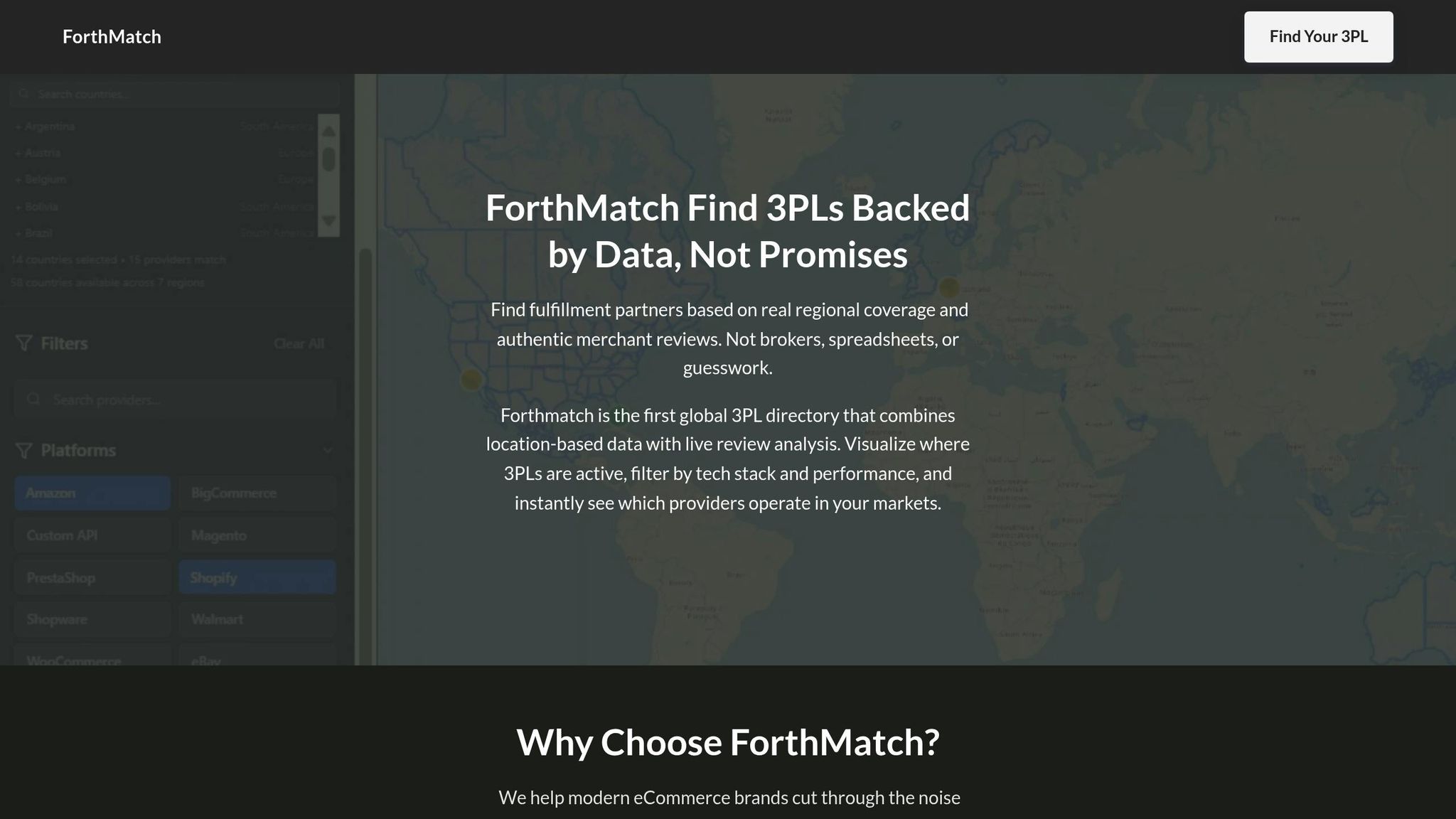
Once you've nailed down your service needs and contract expectations, the next hurdle is finding 3PL providers that can actually meet those requirements. Traditional research methods often come with hidden broker fees and limited access to performance data. That's where Forthmatch steps in - a platform specifically designed to connect DTC brands with reliable logistics partners, minus the headaches.
Forthmatch Features for DTC Brands
Forthmatch streamlines the often-frustrating process of finding the right 3PL with features tailored to the challenges DTC brands face.
Real-time service area mapping takes the mystery out of geographic coverage. Instead of vague promises like "nationwide shipping", Forthmatch provides visual maps that show precise delivery zones - down to 30–60 minute ranges from each warehouse. This clarity makes it easy to see exactly where a 3PL can efficiently serve your customers.
Automated market detection is a game-changer for brands on Shopify. By connecting your store, the platform automatically identifies your key sales regions and matches you with 3PLs that already have a presence in those markets. This is especially helpful for brands expanding internationally, cutting out the need for manual research.
Platform compatibility and technology filtering ensures that any 3PL you consider will integrate seamlessly with your current systems, whether you're using Shopify, WooCommerce, Amazon, or another platform. No more wasting time on providers that can't connect with your tech stack.
Data-driven scoring gives you an unbiased look at each provider's reputation and performance. Unlike rankings influenced by paid placements or commissions, Forthmatch uses real performance metrics to evaluate providers, so you can trust their track record.
Direct provider contact bypasses brokers and their extra fees. Forthmatch connects you directly with 3PLs, letting you negotiate terms and pricing without the added costs that come with intermediaries.
Currently, the platform features over 15 verified 3PLs and operates independently, meaning no referral fees or lead generation cuts - just transparent access to fulfillment data.
Simplifying Provider Comparison and Selection
Forthmatch doesn't just help you find potential partners; it also makes comparing them straightforward and efficient.
Side-by-side provider comparison allows you to evaluate multiple 3PLs at once using clear, objective metrics. Instead of juggling spreadsheets or multiple browser tabs, you can compare factors like geographic coverage, tech compatibility, and service offerings all in one place.
Performance tier and specialty filtering lets you zero in on providers that meet your specific needs. Whether you're looking for climate-controlled storage, subscription box expertise, or international shipping capabilities, you can quickly narrow your options to those that fit your operational standards.
Trust rankings and feedback integration provide a peek into real-world performance. While the platform is relatively new (launched on August 5, 2025) and still building its review database, future updates will incorporate feedback and sentiment scores from sources like Google, Trustpilot, and web mentions. This will give you even more insight into how other merchants rate each provider.
Detailed provider profiles pack all the essential information into one place - team size, operational metrics, service capabilities, and tech integrations. This means you can skip lengthy discovery calls and get straight to the data you need to make informed decisions.
By focusing on transparency and performance-based comparisons, Forthmatch saves you from wasting time on unreliable 3PLs. Its unbiased scoring and clear data indicators help you quickly move from research to meaningful conversations with providers that match your brand's specific logistics needs.
For Shopify-based DTC brands, Forthmatch is especially convenient since it integrates seamlessly with Shopify stores and is available in the Shopify App Store. Plus, with a free access model, you can explore its features without any upfront costs - perfect for brands at any stage of growth.
Once you've used Forthmatch's tools to identify the most promising 3PL candidates, you're ready to take the next steps in finalizing your partnership.
Selecting and Setting Up Your 3PL Partnership
Choosing the right third-party logistics (3PL) provider and setting up a seamless partnership is crucial for smooth operations and long-term success.
Making Your Final 3PL Choice
When narrowing down your options, it’s important to go beyond surface-level evaluations. Here’s how to make a well-informed decision:
Visit facilities in person. While virtual tours can be helpful, they don’t provide the full picture. Seeing the warehouse firsthand allows you to assess cleanliness, organization, and how the staff handles products similar to yours. If you deal with perishables, check for temperature control systems. Also, take a close look at security measures like surveillance cameras and access controls.
Hold detailed planning sessions. Meet with your top candidates to discuss your business needs, including forecasts, seasonal trends, and any special handling requirements. Ask how they plan to manage peak season volumes and what backup strategies they have in place. These discussions will help you gauge their ability to align with your business goals.
Speak with references. Request contacts for current clients in similar industries or with comparable order volumes. When reaching out, ask specific questions about order accuracy, shipping speed, and how the 3PL resolves problems. Instead of just asking if they’re happy, dig into the details of their experience.
Get input from your team. Involve key departments in the decision-making process. For instance, your customer service team should understand how returns and damaged shipments will be managed, while marketing may need to know about packaging options and shipping deadlines for promotions. This collaborative approach can help uncover potential issues early.
Evaluate communication responsiveness. Pay attention to how quickly they respond during the evaluation process and how detailed and proactive their answers are. Their behavior now is likely a good indicator of how they’ll handle your account later.
Check insurance coverage. Confirm that their insurance limits match your inventory value and cover your product types. Some 3PLs may exclude certain categories or have insufficient coverage for high-value items.
Once you’ve made your choice, the next step is ensuring a smooth integration with your operations.
3PL Setup and Integration Best Practices
After selecting a 3PL, setting up the partnership properly is essential for success. Here’s how to get it right:
Start integration early. Begin the process while finalizing contracts. Integrating systems typically takes 2-4 weeks, and rushing this step can lead to data syncing issues. Collaborate with your 3PL’s IT team and your platform developers to create a clear timeline with milestones.
Prepare inventory transfer details. Before shipping, provide detailed SKU information, including dimensions, weights, storage requirements, and high-resolution photos if necessary. Many integration problems stem from mismatched inventory data, so thorough documentation upfront can save headaches later.
Set up automated reporting. Implement systems that give you daily insights into inventory levels, order processing, and shipping performance. Configure alerts for issues like low stock or shipping delays. Most modern 3PLs offer real-time dashboards, but you’ll need to customize them to track metrics relevant to your business.
Develop standard operating procedures (SOPs). Clearly outline processes for returns, damaged goods, and customer service escalations. Specify details like handling gift messages, managing returned items, and processing exchanges. Well-documented SOPs reduce confusion and ensure consistency.
Start with a soft launch. Test the partnership by rolling out a limited product range or region first. This allows you to spot and fix any issues without disrupting your entire operation. Begin with your best-selling, simplest products and expand gradually as processes stabilize.
Hold regular reviews. Schedule weekly meetings during the initial phase, transitioning to monthly once operations are running smoothly. Use these check-ins to review performance metrics, discuss upcoming promotions or seasonal changes, and address any concerns before they impact customers.
Establish backup contacts. Beyond your primary account manager, ensure you have direct contact information for warehouse supervisors, IT support, and senior management. This ensures you can quickly reach the right people when urgent issues arise.
Document everything. Keep detailed records of configuration settings, integration details, and operational agreements. This documentation will be invaluable for troubleshooting and onboarding new team members.
A well-executed setup process lays the groundwork for a successful 3PL partnership, helping you avoid costly mistakes and ensuring your operations run smoothly as your business expands.
Conclusion: Using Matched 3PL Services for DTC Growth
Choosing the right 3PL partner lays the groundwork for scaling your business effectively. A careful selection process ensures that your provider can meet your current requirements while also supporting future growth.
The benefits are clear: 73% of shippers report that working with a 3PL has improved their customers' experiences, and 86% say it has increased cost-efficiency in logistics operations. This is where a streamlined platform can make all the difference.
Forthmatch simplifies the process by offering direct and transparent comparisons of providers. Instead of waiting on quotes or dealing with brokers, you can evaluate providers based on factors like delivery reach, platform compatibility, and real merchant reviews.
Tailored solutions and flexibility are essential for successful partnerships. The best DTC-3PL relationships go beyond basic fulfillment to include options like custom packaging, specialized handling, and adjustable service levels that reflect your brand’s values and evolving needs. These customizations, paired with a solid operational structure, ensure that your logistics strategy delivers results. Steps like seamless integration, precise inventory management, and open communication are key to making this work. Starting with a soft launch and conducting regular performance reviews can help address potential issues early and keep the partnership aligned with your goals.
As eCommerce and DTC brands continue to grow globally, the logistics industry has seen a notable increase in 3PL providers. This makes having the right evaluation tools and criteria even more critical. Brands that prioritize compatibility and long-term alignment - rather than just low costs or convenience - set themselves up for consistent growth and exceptional customer satisfaction.
A truly aligned 3PL partner acts as an extension of your team. When that alignment is achieved, your 3PL becomes a strategic advantage, enhancing customer experience and driving business expansion. That’s the kind of partnership that fuels DTC growth.
FAQs
How do I choose a 3PL provider that aligns with my DTC brand's values and goals?
To choose a 3PL provider that fits your DTC brand's goals and values, start by pinpointing what matters most to your business. Whether it's speedy delivery, eco-conscious solutions, or delivering an outstanding customer experience, knowing your priorities will guide your search. Focus on providers with a proven history of supporting businesses that share your values and operational needs.
As you evaluate potential partners, make sure to communicate your brand's standards and expectations clearly. Check if they can meet your specific needs, like integrating with your platforms, meeting delivery timelines, or adopting sustainable practices. Look for providers who show adaptability, openness, and a dedication to helping you succeed over the long haul.
Tools like Forthmatch can make this process easier by letting you compare vetted 3PL providers based on real-world reviews, service offerings, and compatibility with your business. This way, you can find a logistics partner that not only supports your operations but also helps elevate your customer experience and strengthen your brand’s reputation.
What should I look for in a 3PL provider to ensure they can handle custom packaging and special handling for my DTC brand?
When choosing a 3PL provider for your DTC brand, look for options that include custom packaging services. This could mean branded boxes, personalized inserts, or distinctive materials that align with your brand’s image. It’s also important to confirm they offer specialized handling for products needing extra attention - like temperature-controlled storage, careful handling of fragile items, or adherence to specific regulations.
These features don’t just protect your products; they also elevate the unboxing experience for your customers, making your brand more memorable in a crowded marketplace.
How can Forthmatch help me choose the best 3PL provider for my DTC brand?
Forthmatch makes it easier for DTC brands to connect with the perfect 3PL provider through its free, detailed directory of pre-screened logistics partners. This platform lets you compare providers based on delivery coverage, platform integrations, pricing, and merchant reviews, helping you find a partner that fits your unique requirements.
By cutting out brokers, avoiding hidden fees, and skipping complicated quote forms, Forthmatch ensures a straightforward and transparent way to explore fulfillment options. With features like real-time service area maps and customizable filters, it empowers you to make informed logistics decisions quickly and with confidence.
